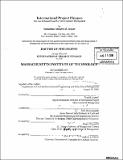| dc.contributor.advisor | Donald Lessard and Fred Moavenzadeh. | en_US |
| dc.contributor.author | Al-Jassar, Sulaiman Ahmed | en_US |
| dc.contributor.other | Massachusetts Institute of Technology. Dept. of Civil and Environmental Engineering. | en_US |
| dc.date.accessioned | 2009-10-14T15:43:09Z | |
| dc.date.available | 2009-10-14T15:43:09Z | |
| dc.date.issued | 2005 | en_US |
| dc.identifier.uri | http://dspace.mit.edu/handle/1721.1/46553 | en_US |
| dc.identifier.uri | http://hdl.handle.net/1721.1/46553 | |
| dc.description | Thesis (Ph. D.)--Massachusetts Institute of Technology, Dept. of Civil and Environmental Engineering, 2005. | en_US |
| dc.description | "September 2005." | en_US |
| dc.description | Includes bibliographical references (leaves 148-150). | en_US |
| dc.description.abstract | This thesis examines the record of the Kuwait Fund for Arab Economic Development (KFAED) in light of changing fashions regarding the proper role and management of such funds in the development finance process. The key questions addressed are whether its concessional aid is allocated according to Donor Interest (DI) or Recipient Needs (RN), what precisely is the grant element in KFAED loans, whether this grant allocation is consistent with the fund's stated policy and if it is linked to one or more of the currently held views regarding how aid should be allocated in order to be most effective - to overcome the "two gaps," to strengthen institutions and governance or to reward/incentivize effective macroeconomic management. The KFAED is an interesting and important subject of study for many reasons. After Saudi Arabia, Kuwait is the second largest Arab aid donor, having contributed a total of more than $18.5 billion between 1960 and 2002. It was the first to officially establish a bilateral aid institution: KFAED, which purports to be free of mercantilist motives as its aid is not tied to procurement, as is the case with most developed countries' aid institutions. The thesis consists of three mutually dependent sections. The first surveys the domain of theoretical and empirical development economics since World War II. It reviews its evolution over time, linking successes and failures in development aid to the refinement of macroeconomic points of view among various schools of thought. Since the implementation of any economic policy is highly sensitive to the political goals of the policy makers, we show that the evolution of macroeconomic theory is not, in itself, able to account for Kuwait Foundation for the Advancement of the Science's partial funding of this research, under grant 2005-12-01, is acknowledged. changes in the pattern of development aid. "Fashions" in such aid reflect not only the past history of aid itself, but also the histories of the donor nations or their multi-lateral vehicles. Our specific interest in regional Arab geopolitical development is contextualized in order to trace the effects of development theory evolution on the Middle Eastern region. | en_US |
| dc.description.abstract | (cont.) The second section studies the aid allocation of the KFAED. It seeks to determine, among other things, whether the allocation of aid reflects recipient needs or donor interest. We modeled the allocation decision as a two-stage process: selection and allocation. The empirical analysis demonstrates that income, ethnicity, religion and politics are all factors in the selection stage. Arab, Muslims countries and more populous countries receive a higher share of the total aid allocated (allocation stage). The third section extends the second by adding the third stage: grant element determination. It addresses two questions: how grant element is calculated and what factors influence its allocations. In addressing the first question, we offer a rationale for an adjusted discount rate in calculating grant element--the percentages of subsidy embedded in the loan. When this rate is applied, the results point to consistent overestimation of the traditionally published grant element statistics. We then examine the grant element allocation. We find that the actual allocation is quite different than that implied by the stated policy of the KFAED. Chief among the sources of variation are political factors, income and sectors. Finally, we test to see if the current grant element allocation is in line with any of the three views regarding how aid should be allocated: the two gap, macroeconomic management, and governance and institutions building. We find that it is weakly related to the two-gap view, but appears to bear no relation to the other two. | en_US |
| dc.description.statementofresponsibility | by Sulaiman Ahmed Al-Jassar. | en_US |
| dc.format.extent | 156 leaves | en_US |
| dc.language.iso | eng | en_US |
| dc.publisher | Massachusetts Institute of Technology | en_US |
| dc.rights | M.I.T. theses are protected by
copyright. They may be viewed from this source for any purpose, but
reproduction or distribution in any format is prohibited without written
permission. See provided URL for inquiries about permission. | en_US |
| dc.rights.uri | http://dspace.mit.edu/handle/1721.1/46553 | en_US |
| dc.rights.uri | http://dspace.mit.edu/handle/1721.1/7582 | en_US |
| dc.subject | Civil and Environmental Engineering. | en_US |
| dc.title | International project finance : the case of Kuwait Fund for Arab Economic Development | en_US |
| dc.title.alternative | Case of Kuwait Fund for Arab Economic Development | en_US |
| dc.title.alternative | KFAED | en_US |
| dc.type | Thesis | en_US |
| dc.description.degree | Ph.D. | en_US |
| dc.contributor.department | Massachusetts Institute of Technology. Department of Civil and Environmental Engineering | |
| dc.identifier.oclc | 419565673 | en_US |
